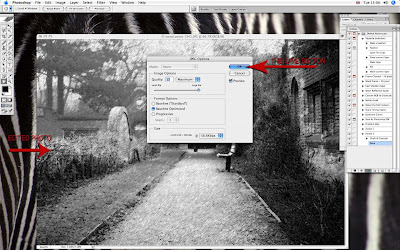Ross @ Media out.


 I didn’t lean all that much if I am totally honest. As our title sequence was made out of still photographs and I used my own personal camera to take photos I already new how to use it before we stared the project. Whilst photographing we did have one tripod which did enable us to get more steady shots, but as both myself and George were taking pictures at the same time on separate cameras this meant only one of us could use at a time. However this wasn’t too much of a problem as after looking through the photos and stringing a few together we decide that we preferred the rougher, more jumpy images anyway.
I didn’t lean all that much if I am totally honest. As our title sequence was made out of still photographs and I used my own personal camera to take photos I already new how to use it before we stared the project. Whilst photographing we did have one tripod which did enable us to get more steady shots, but as both myself and George were taking pictures at the same time on separate cameras this meant only one of us could use at a time. However this wasn’t too much of a problem as after looking through the photos and stringing a few together we decide that we preferred the rougher, more jumpy images anyway. wever after doing some research we discovered that it was possible to set up a list of commands so that the computer could edit and save the photos itself and all we had to do was push ‘ok’. This idea worked as it saved time, but it was very memory hungry so we had to use my hard disk as extra storage space for the edited photos. Despite the discovery of the command tool it still took about two days in total to edit all 1500 photos used in the sequence, but at least we only had to push ‘ok’ and could watch films whilst doing so.
wever after doing some research we discovered that it was possible to set up a list of commands so that the computer could edit and save the photos itself and all we had to do was push ‘ok’. This idea worked as it saved time, but it was very memory hungry so we had to use my hard disk as extra storage space for the edited photos. Despite the discovery of the command tool it still took about two days in total to edit all 1500 photos used in the sequence, but at least we only had to push ‘ok’ and could watch films whilst doing so. deal with two of the biggest fears, death and spiders. People may wish to se how either the two are combined so that they can learn to either escape from them or also how to deal with them.
deal with two of the biggest fears, death and spiders. People may wish to se how either the two are combined so that they can learn to either escape from them or also how to deal with them.



 hould be slightly odd in either how they kill or dispose of the bodies, although a lot more serious, This led us to the idea Dr Hannibal Lecter and Silence of the Lambs which helped us to continue to look at mental illness and schizophrenia which then led onto the idea of a dangerous obsession. After much thought and research we decided spiders would be a good choice. The idea being that the killer would place magnus opium, which is basically a spider’s egg, into the victim’s mouth so that after a few weeks the spider would hatch eating the body and destroying it before either the police found it or had a chance to gather any forensic evidence from it.
hould be slightly odd in either how they kill or dispose of the bodies, although a lot more serious, This led us to the idea Dr Hannibal Lecter and Silence of the Lambs which helped us to continue to look at mental illness and schizophrenia which then led onto the idea of a dangerous obsession. After much thought and research we decided spiders would be a good choice. The idea being that the killer would place magnus opium, which is basically a spider’s egg, into the victim’s mouth so that after a few weeks the spider would hatch eating the body and destroying it before either the police found it or had a chance to gather any forensic evidence from it. ed how menacing the drawings looked when coloured in black, white and red but unfortunately my group weren’t quite so sure on the idea, so we decided to stick with simple black and white. We also began to look at examples of Japanese horror films as they are renowned for being physiologically scary. This helped us develop the idea of the close-ups of eyes and faces etc, which are typical forms of the thriller and horror genre as they are used to scare and unsettle people.
ed how menacing the drawings looked when coloured in black, white and red but unfortunately my group weren’t quite so sure on the idea, so we decided to stick with simple black and white. We also began to look at examples of Japanese horror films as they are renowned for being physiologically scary. This helped us develop the idea of the close-ups of eyes and faces etc, which are typical forms of the thriller and horror genre as they are used to scare and unsettle people.